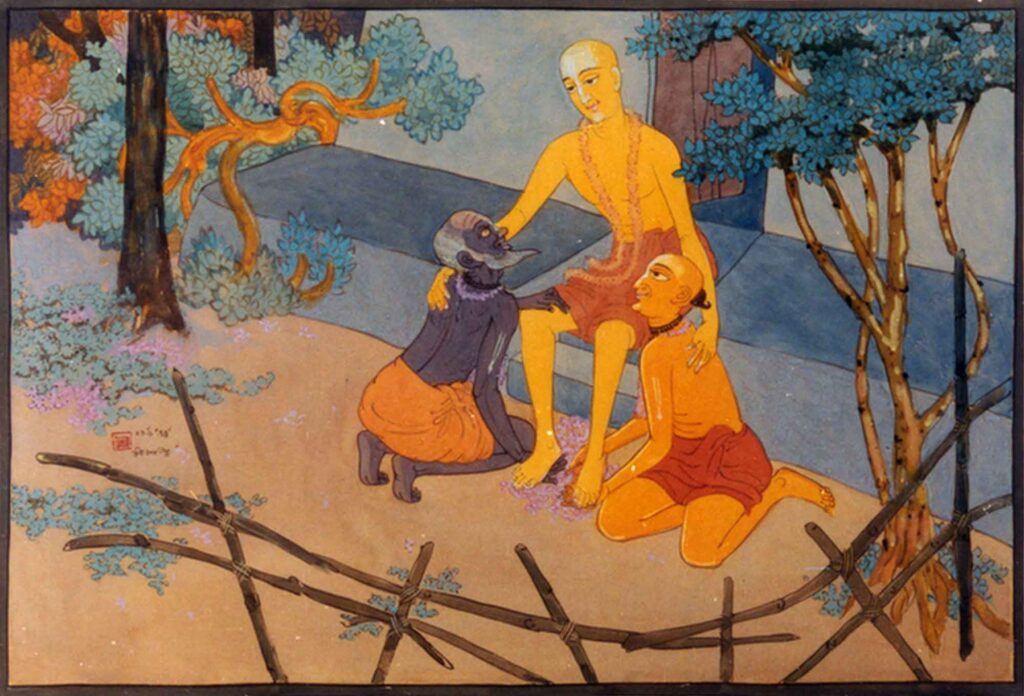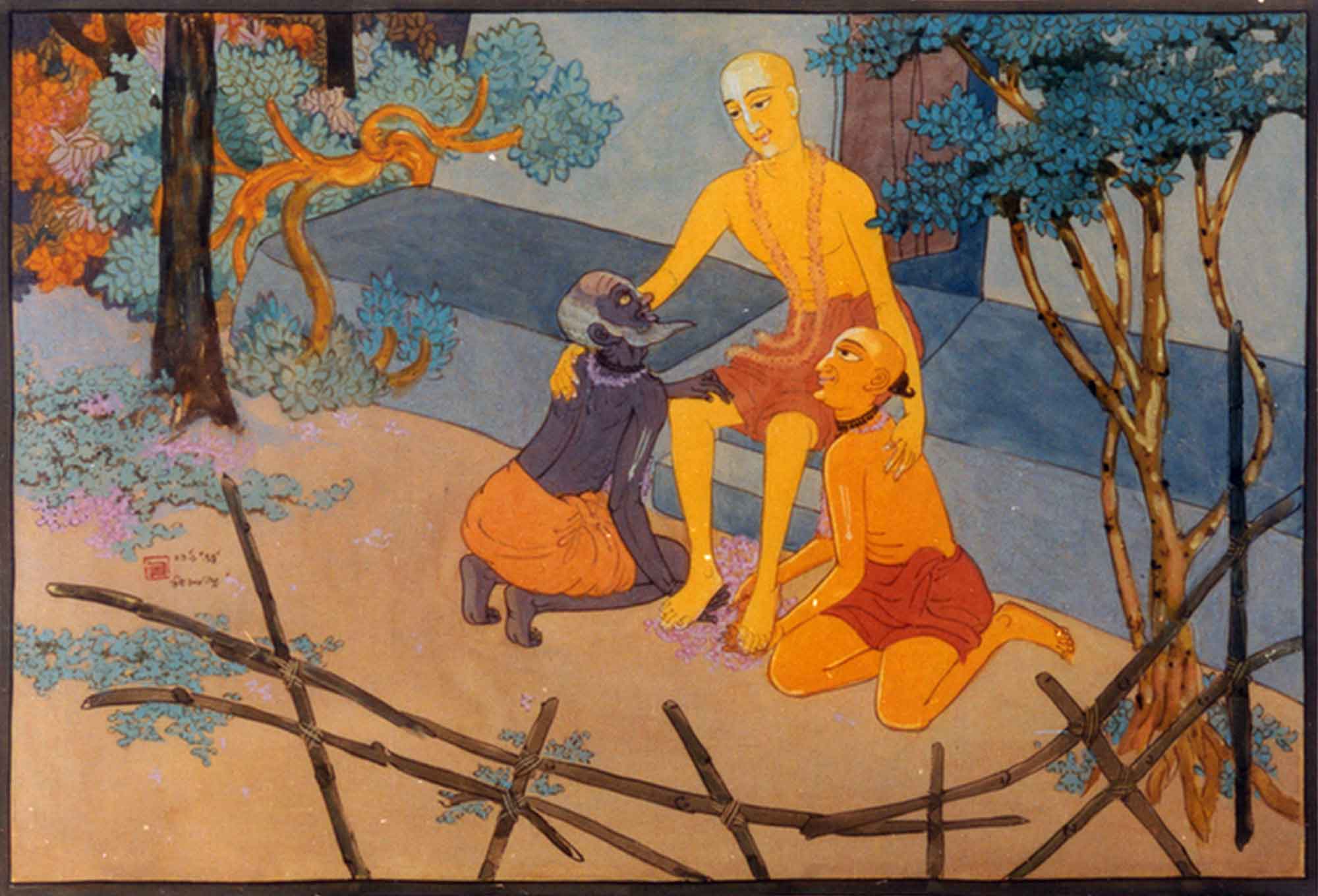Overview
Bhaktivinoda Ṭhākura writes about how the process of sādhana is necessary for increasing one’s thirst to attain the Supreme, in this article first published in 1899, in the 11th Volume of Sajjana Toṣaṇī.
(translated by Gaudiya Vedanta Publications)
The jīva’s aversion to Bhagavān is the result of his desire for sense-enjoyment; consequently, he wanders throughout this world with the hope of attaining happiness. As long as his desire for worldly happiness does not wane, an inclination to serve Bhagavān cannot possibly arise in him. However, with the accumulation of abundant sukṛti, or spiritual merit, his desire for worldly enjoyment slackens. This is the result of Bhagavān’s gradual mercy upon him. It is then that the desire for sādhu-saṅga, the association of saintly persons, arises within him naturally.
Śraddhā, or transcendental faith, arises by discussing topics about Kṛṣṇa in sādhu-saṅga. With the jīva’s increasing effort to engage in the cultivation of activities related to Kṛṣṇa, a greed to attain Bhagavān appears within him. At that time, one should accept the shelter of the lotus feet of a guru whose character is spotless and who has full knowledge of philosophical truths. One should learn the art of bhajana from such a guru. Only by the strength of his bhajana does the jīva attain the complete mercy of Bhagavān.
In the jīva’s condition of being completely captivated by māyā, he must accept the activities of sādhana as indispensable in order to become eligible to attain the mercy of Bhagavān. Śrīman Mahāprabhu has Himself said, sādhana vina jīvera sādhya vastu keha nāhi pāya – “a jīva who does not perform sādhana does not attain his goal, or sādhya.” Although a person may have attained a little śraddhā, if he is lazy about performing the activities of sādhana and simply sits back and hopes to attain Kṛṣṇa’s mercy, he will not receive any real benefit. His life will simply pass by uselessly.
Kṛṣṇa is the embodiment of mercy, and in bestowing His boundless compassion upon the jīvas, He has manifested the Vedic scriptures. Furthermore, He descends in every yuga and preaches the specific dharma, or spiritual means for deliverance, for that yuga. In this way, He endeavours to make all jīvas understand those Vedic scriptures and become favourably inclined toward Him. Particularly in Kali-yuga, His mercy is available without restriction. Those who do not become inclined to perform sādhana to attain Kṛṣṇa, despite having such an opportunity, simply have no hope of ever attaining auspiciousness.
Śrī Kṛṣṇa-candra is supremely independent. If He so desires, He can give His darśana to the jīva. That said, if a person’s heart lacks eagerness to perform even a little sādhana to attain Him, then that person’s yearning for Kṛṣṇa cannot be genuine. Rather, it is simply a semblance of real hankering. Such a person would not in fact be satisfied even by the direct darśana of Bhagavān, but would return to this world from Vaikuṇṭha to fulfil his hankering for the worthless happiness of this world.
The process of sādhana is nothing but the art of increasing one’s thirst to attain Bhagavān. A person receives the mercy of Kṛṣṇa in proportion to the intensity of this thirst, which develops by performing sādhana marked by care and eagerness. When such sādhana is fully matured, Kṛṣṇa manifests Himself to that person. He cannot withhold Himself.
The conditioned jīva will never achieve success if he relinquishes the activities of sādhana; he must embrace them with great care. He will approach perfection to the extent that he performs sādhana with honour.
Śrīla Rūpa Gosvāmī has stated:
nitya-siddhasya bhāvasya prākaṭyaṁ hṛdi sādhyatā
Sādhana is the process of awakening the eternal dormant propensity within one’s heart to love Kṛṣṇa. (Bhakti-rasāmṛta-sindhu 1.2.2)
The jīva’s eternal constitutional nature is to be a servant of Bhagavān; and his eternal occupation is bhāgavata-prema, to render loving service to Bhagavān. In the jīva’s conditioned state, his eternally perfect love is observed in the form of his love for sense objects. Sādhana is the process that revokes that love from the sense objects and causes this eternal love to appear in the heart.
The śāstras delineate the various limbs of sādhana. Śrīla Rūpa Gosvāmī has divided these into sixty-four divisions in his book Bhakti-rasāmṛta-sindhu. Śrīmad-Bhāgavatam divides them into nine forms, namely, śravaṇaṁ, kīrtanaṁ, smaraṇaṁ, etc. The essence of all sādhana, especially in Kali-yuga, is hari-nāma – to chant the holy names of Kṛṣṇa.
When the best of scholars, Vāsudeva Sārvabhauma, wished to know what is the highest sādhana, Śrīman Mahāprabhu replied that hari-nāma-saṅkīrtana is topmost. This is described in Śrī Caitanya-caritāmṛta (Madhya-līlā 6.241):
bhakti-sādhana-śreṣṭha śunite haila mana
prabhu upadeśa kaila nāma-saṅkīrtana
Śrī Mahāprabhu also spoke the following words to Śrī Sanātana Gosvāmī:
bhajanera madhye śreṣṭha nava-vidhā bhakti
‘kṛṣṇa-prema’ kṛṣṇa’ dite dhare mahā-śakti
tāra madhye sarva-śreṣṭha nāma-saṅkīrtana
niraparādhe nāma laile pāya prema-dhana
Among the various methods of performing bhajana, the best is to execute the nine prescribed processes of bhakti. These processes carry the outstanding potency to bestow both kṛṣṇa–prema and Kṛṣṇa. Among the nine processes of bhakti, chanting the holy names is foremost. If one chants without committing any offences, one easily receives the treasure of pure love for Kṛṣṇa. (Śrī Caitanya-caritāmṛta, Antya-līlā 4.70–71)
In this Kali-yuga, there is no other refuge for the jīva than chanting the names of Hari. Indeed, hari-nāma is the only sādhana, and the other limbs of sādhana are accepted as its assistants.
In śāstra we find the statement “‘eka’ aṅga sādhe, keha sādhe ‘bahu’ aṅga – some practice a single limb, whereas others practice many.” However, no one should think he can attain perfection by taking shelter of any limb other than hari-nāma. When a sādhaka understands hari-nāma to be the topmost sādhana and takes one-pointed shelter of nāma, he can also perform the other limbs of sādhana. Śāstra clearly declares:
harer nāma harer nāma harer nāmaiva kevalam
kalau nāsty eva nāsty eva nāsty eva gatir anyathā
To attain one’s spiritual goal in Kali-yuga, there is no other way, there is no other way, there is no other way than to chant the holy name, chant the holy name, chant the holy name.
Whoever is the recipient of Śrīman Mahāprabhu’s mercy will single-mindedly take shelter of hari-nāma without any duplicity. As he performs sādhana of hari-nāma and gradually attains perfection, he will come to realise nāma in the form of his sādhya, or goal. This is because Kṛṣṇa’s name is both the goal and the means to attain it. There is no difference between Kṛṣṇa’s name (nāma) and Kṛṣṇa Himself, the possessor of the name (nāmī).
It is necessary to deliberate a little on the subject of the practice, or sādhana, of śrī nāma. Sādhana is performed with the senses. Therefore, it is essential that the sādhaka firmly and expertly engage his senses in the activities of sādhana. One can perform the practices of sādhana in a charming way if one keeps the body healthy. This can be achieved by regulating one’s eating (yukta-āhāra) and recreation (yukta-vihāra). In other words, if a person tortures his body by being falsely renounced, then all his senses become disabled. Consequently, instead of the sādhaka performing sādhana, he forfeits his life. In this regard, Bhagavān says in the Bhagavad-gītā (6.16–17):
nāty-aśnatas tu yogo ’sti na caikāntam anaśnataḥ
na cāti-svapna-śīlasya jāgrato naiva cārjuna
O Arjuna, yoga cannot be perfected by one who eats too much or too little, or who sleeps too much or too little.
yuktāhāra-vihārasya yukta-ceṣṭasya karmasu
yukta-svapnāvabodhasya yogo bhavati duḥkha-hā
For one who is moderate in eating and recreation, balanced in work, and regulated in sleeping and wakefulness, his practice of yoga destroys all material miseries.
The meaning here is that one who eats too much or hardly eats at all, who sleeps a lot or does not sleep enough, is never able to use his body and senses to perform the activities of sādhana. If a person does not allow his body to become unhealthy or his senses in active – by regulating all his endeavours including his eating, recreation, sleeping and waking – then his sādhana will be executed exquisitely and it will destroy all his miseries. The implication is that one must engage one’s internal sense, the mind, in remembering and meditating upon śrī nāma, by protecting it from the four anarthas, or impediments to spiritual progress. These impediments are misconceptions about reality (svarūpa-bhrama), the hankering for temporary objects (asat-tṛṣṇā), weakness of the heart in adopting the process of bhakti (hṛdaya-daurbalya) and offences (aparādha). Moreover, one’s external senses should be protected from becoming habituated to activities that are unfavourable to one’s bhajana, such as over-eating, over-sleeping and endeavouring for sense objects. Instead, they should be incessantly engaged in the sādhana of nāma-kīrtana. The capacity to do so is indeed the expertise of a sādhaka.
It is necessary for a sādhaka to be both vigilant and resolute in accepting what is favourable for his bhakti and rejecting what is unfavourable. Often various unfavourable things come into the life of a jīva in this material world, and if he does not carefully and decisively reject them, they will hinder his sādhana and delay him in attaining his cherished goal.
Sometimes one may think: “Let me do what is unfavourable for my sādhana today, and from tomorrow I will take special care to avoid this.’’ But one who manifests such weakness of heart (hṛdaya-daurbalya) will never attain auspiciousness. As soon as a sādhaka perceives something to be an obstacle to his bhajana, he should give it up immediately and embrace the mercy of Śrīman Mahāprabhu. Determination is indeed the foundation of sādhana. If a person lacks determination, he cannot progress even a single step in his sādhana.
The sādhu is the sādhaka’s primary benefactor. The heart of the baddha-jīva is so captured by anarthas, that he cannot single-handedly remove them, despite his arduous attempts to do so. For one who remains in sādhu-saṅga, however, anarthas have no chance of manifesting. Śrīla Narottama Ṭhākura Mahāśaya has rightly said:
kivā vā karite pare, kāma-krodha sādhakera
yadi haya sādhujanāra saṅga
What can lust and anger do to a sādhaka if he is in the association of sādhus?
Sādhu-saṅga is absolutely essential for one who wants to properly perform the activities of sādhana. Śrīman Mahāprabhu has said:
kṛṣṇa-bhakti-janma-mūla haya ‘sādhu-saṅga’
kṛṣṇa-prema janme, teṅho punaḥ mukhya aṅga
The underlying cause of the birth of bhakti to Śrī Kṛṣṇa is sādhu-saṅga. Even after kṛṣṇa-prema awakens in the heart, sādhu-saṅga remains the foremost principle. (Śrī Caitanya-caritāmṛta, Madhya-līlā 22.83)
mahat-kṛpā vinā kona karme ‘bhakti’ naya
kṛṣṇa-bhakti dūre rahu, saṁsāra nahe kṣaya
Unless a person is blessed by an exalted saint, none of the activities he performs can be considered to be bhakti. What to say of attaining kṛṣṇa-bhakti, it is impossible for him even to extricate himself from material existence. (Śrī Caitanya-caritāmṛta, Madhya-līlā 22.51)
If one can chant the holy name in the association of a pure devotee who is attached to chanting, all his offences will be dispelled and nāma-tattva will quickly manifest in his heart. Our prayer at the lotus feet of Śrīmān Mahāprabhu is that by incessantly chanting the holy name in the association of a śuddha-bhakta we may soon experience the sweetness (rasa) of śrī nāma. We pray for nothing other than the mercy of śrī nāma.
(Sādhana by Bhaktivinoda Ṭhākura was first published in 1899, in the 11th Volume of Sajjana Toṣaṇi and translated by Gaudiya Vedanta Publications)













